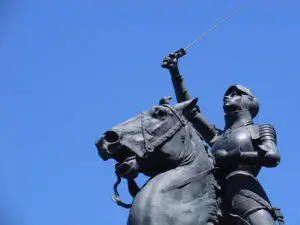Gender & Fiction
Literature and film have the power to imagine new ways for people to live and to interact with each other. Fiction may reflect prevalent ideas about gender, but it also shapes those ideas through dramatic situations. Since gender is a type of social action, fiction–stories driven by characters’ actions–is well suited to depict gender notions.
Gender is not an identity or a thing, but a set of social practices. One’s gender practices evolve in relation to other people, over time, and in different social spaces. It is both personal and political to claim or renounce a particular gender role.
An example of the power of fiction is the medieval legend of Joan of Arc that is still very much alive today. During the Hundred Years’ War in the fifteenth century, a French peasant named Joan of Arc wore men’s clothes and led the French army to victory against English invaders. Subsequently captured, Joan was burned to death by the English and their French collaborators as a heretic. Joan of Arc is now a French national heroine and lauded as one of the earliest feminists.
In 2022, the Globe Theatre in London staged an adaptation of the legend of Joan of Arc. Isobel Thom played Joan as a nonbinary person rather than as a cisgender woman. This production caused an uproar and re-ignited bitter debates about individuals’ right to self-determination.
It raised the question: If the historical Joan does not identify as cisgender woman, does the legend undermine feminist causes?
What did Joan of Arc say about their choice of male attire? Joan of Arc said wearing men’s clothes was more pragmatic on the battlefield. They told a French court in 1431 that it “was necessary that I changed my clothes.”
The keyword here is necessary. Joan put on men’s clothes not only to lead an army but also to be themselves which should not require further justification. To be able to make their own decision about clothing was a necessary act for Joan to live a livable life.

